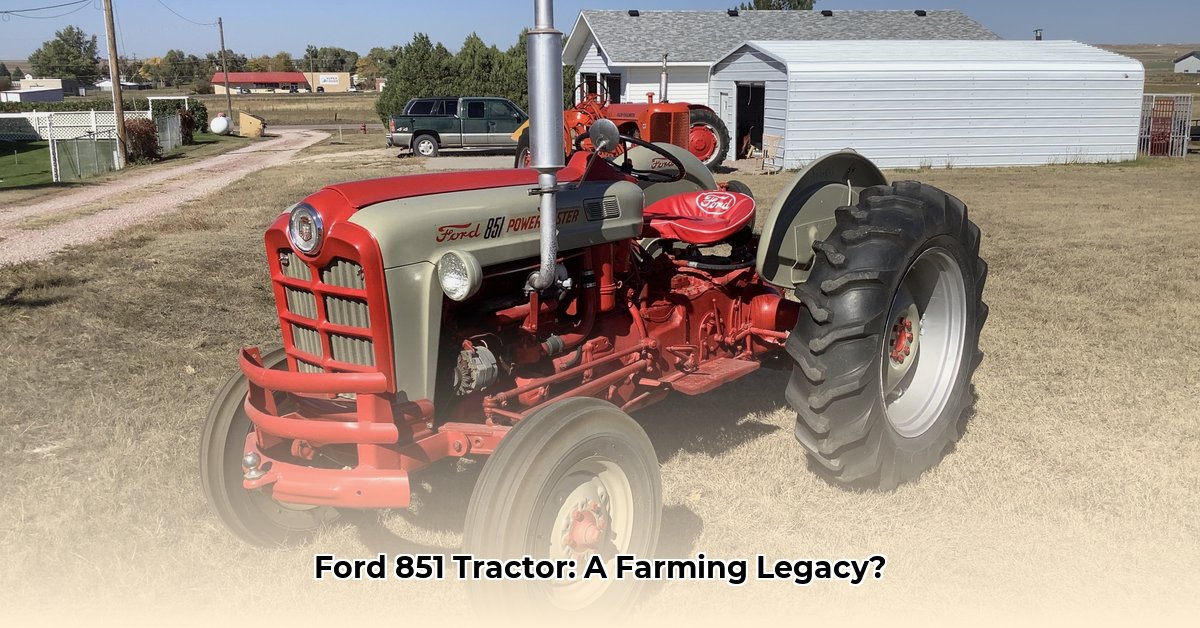
The Ford 851 Powermaster, a stalwart of fields from 1957 to 1962, offers a compelling case study in the evolution of agricultural technology and its relationship to sustainable farming practices. While its 62.6 horsepower and 17-gallon fuel tank were impressive for its time, how does this vintage machine inform our contemporary understanding of sustainable agriculture? This article will explore the Ford 851's design, fuel efficiency (or lack thereof), and long-term implications for modern eco-conscious farming. For more Ford tractor models, check out this helpful resource.
The Ford 851: A Closer Examination
The Ford 851's fuel economy, by today's standards, is far from efficient. Its reliance on fossil fuels directly contradicts modern sustainability goals. However, its robust construction and readily available repair manuals (even online) demonstrate impressive longevity. Fewer replacements translate to reduced waste and a smaller environmental footprint from manufacturing and disposal. A significant percentage of modern machinery does not offer this longevity; this begs the question: how can we design modern equipment with the same durability of the 851?
The Ford 851 Through a Sustainability Lens
Analyzing the Ford 851's impact requires considering various stakeholders:
| Stakeholder | Short-Term Impact | Long-Term Impact |
|---|---|---|
| Agricultural Historians | Enhanced understanding of early agricultural technology. | A more complete understanding of older farm equipment's environmental effect. |
| Sustainable Agriculture Researchers | Assessing the Ford 851's environmental footprint throughout its lifespan. | Comparing the lifecycles of older and newer tractors to enhance comprehension of sustainability. |
| Vintage Tractor Enthusiasts | Restoring and maintaining functional Ford 851s. | Potentially inspiring new designs for more durable, eco-friendly machinery. |
| Policy Makers | Using historical data to inform policies supporting farm equipment. | Developing policies promoting research into more efficient and sustainable farm equipment and fuel. |
Risks and Rewards: Challenges and Solutions
The Ford 851, like any technology, presented challenges:
| Factor | Potential Risk Level | Mitigation Strategies |
|---|---|---|
| Heavy Reliance on Fossil Fuels | High | Transitioning to alternative fuels (like biodiesel) in modern tractors; research into sustainable biofuels. |
| Mechanical Reliability – Parts Availability | Moderate | Regular maintenance; fortunately, parts remain relatively accessible, although this may change. |
| Operator Safety (Open-air Design) | Moderate | Modern safety standards are crucial; future designs should prioritize operator well-being. |
| Historical Environmental Impact | High | Careful comparison of vintage and modern machinery life-cycle environmental impacts; ongoing research is vital. |
Lessons from the Past: A Broader Perspective
Studying the Ford 851 transcends mere nostalgia; it provides a valuable lesson. It illustrates the evolution of farming technology and the ongoing pursuit of sustainable practices. The tractor’s history emphasizes that sustainable agriculture isn't solely dependent on the latest technology. It's about understanding the long-term consequences of our choices and their impact on the environment and future generations. Further research into the long-term environmental effects of various agricultural technologies is crucial, and the 851 offers a valuable historical perspective.
Calculating the Carbon Footprint of a Vintage Ford 851 Tractor: A Herculean Task
Accurately calculating the carbon footprint of a 1950s tractor like the Ford 851 is extremely difficult. While its impact on productivity was undeniable, measuring its precise environmental impact requires navigating a complex set of historical limitations.
The Challenges of Retroactive Carbon Accounting
The lack of detailed fuel efficiency data, precise operational lifespan information, and repair rates for the Ford 851 presents a significant hurdle. These factors are crucial in determining its overall contribution to greenhouse gas emissions.
Estimation Techniques: Bridging the Data Gap
Approximating the 851's footprint can involve comparing it to similar tractors of the era. Analyzing fuel consumption data from comparable models offers a possible estimate. Factoring in the typical lifespan of such machines allows for a time-based assessment of emissions. Finally, analyzing manufacturing and disposal processes associated with the tractor are additional essential considerations.
Leveraging Modern Tools
While historical data for the Ford 851 is incomplete, resources like the EPA's Greenhouse Gas Reporting Program provide frameworks for carbon accounting, though not specifically developed for vintage machinery. [1] https://www.epa.gov/ghgemissions/overview-greenhouse-gases
The Broader Implications
The difficulties in calculating the Ford 851's carbon footprint highlight the critical need for thorough data collection in modern agriculture. Unlike the 851, modern tractors are designed with emission reduction in mind, making lifecycle analysis more readily available. The 851’s legacy should serve as a potent reminder of the need to couple efficiency with genuine environmental responsibility.
Key Takeaways:
- The Ford 851's sustainable agriculture impact is complex and difficult to fully quantify due to data limitations.
- Estimating the 851's carbon footprint requires comparative analysis with similar tractors. Lifespan, fuel consumption, and manufacturing processes must be factored in.
- Modern tools assist with estimations, despite not being designed for historical analysis.
- The challenges in assessing the 851's impact underscore the importance of comprehensive data collection in modern agriculture.